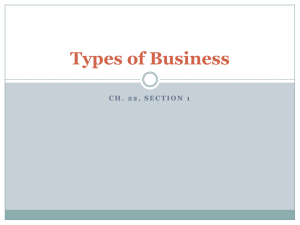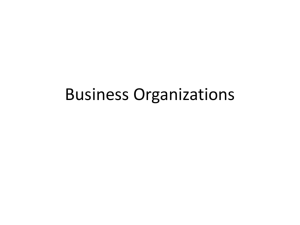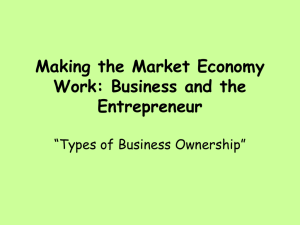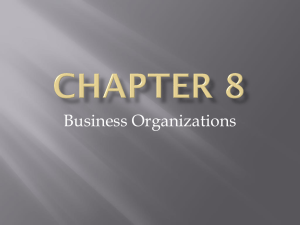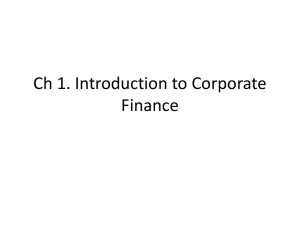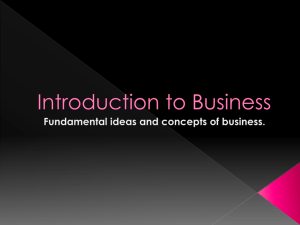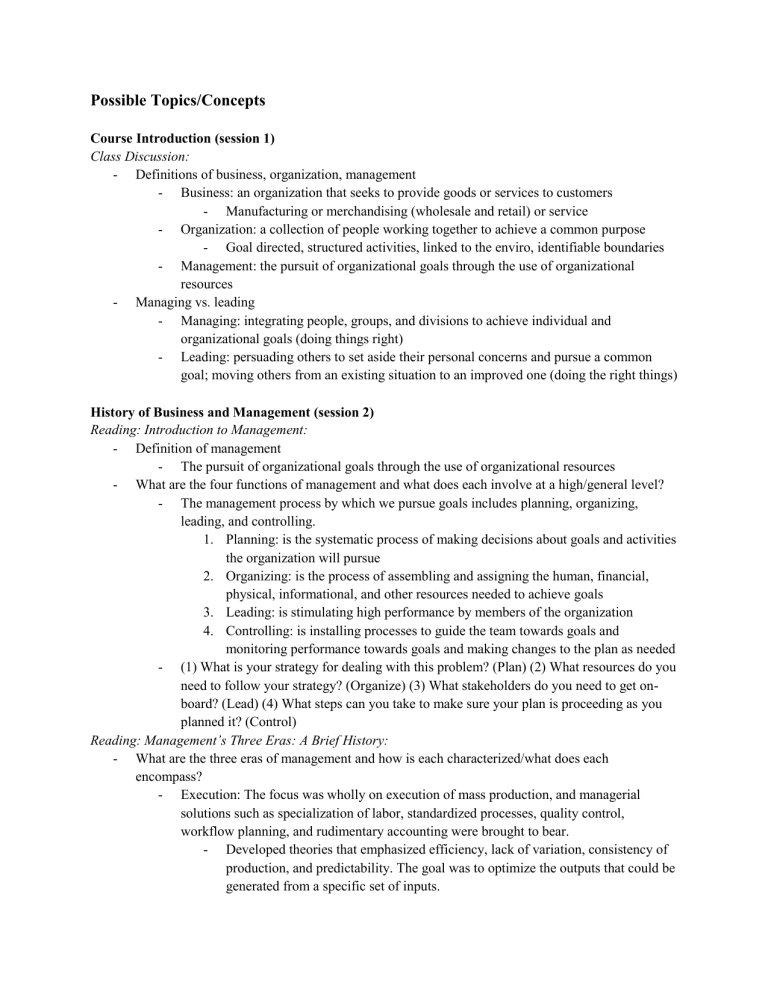
Possible Topics/Concepts Course Introduction (session 1) Class Discussion: - Definitions of business, organization, management - Business: an organization that seeks to provide goods or services to customers - Manufacturing or merchandising (wholesale and retail) or service - Organization: a collection of people working together to achieve a common purpose - Goal directed, structured activities, linked to the enviro, identifiable boundaries - Management: the pursuit of organizational goals through the use of organizational resources - Managing vs. leading - Managing: integrating people, groups, and divisions to achieve individual and organizational goals (doing things right) - Leading: persuading others to set aside their personal concerns and pursue a common goal; moving others from an existing situation to an improved one (doing the right things) History of Business and Management (session 2) Reading: Introduction to Management: - Definition of management - The pursuit of organizational goals through the use of organizational resources - What are the four functions of management and what does each involve at a high/general level? - The management process by which we pursue goals includes planning, organizing, leading, and controlling. 1. Planning: is the systematic process of making decisions about goals and activities the organization will pursue 2. Organizing: is the process of assembling and assigning the human, financial, physical, informational, and other resources needed to achieve goals 3. Leading: is stimulating high performance by members of the organization 4. Controlling: is installing processes to guide the team towards goals and monitoring performance towards goals and making changes to the plan as needed - (1) What is your strategy for dealing with this problem? (Plan) (2) What resources do you need to follow your strategy? (Organize) (3) What stakeholders do you need to get onboard? (Lead) (4) What steps can you take to make sure your plan is proceeding as you planned it? (Control) Reading: Management’s Three Eras: A Brief History: - What are the three eras of management and how is each characterized/what does each encompass? - Execution: The focus was wholly on execution of mass production, and managerial solutions such as specialization of labor, standardized processes, quality control, workflow planning, and rudimentary accounting were brought to bear. - Developed theories that emphasized efficiency, lack of variation, consistency of production, and predictability. The goal was to optimize the outputs that could be generated from a specific set of inputs. - - Ownership of capital, which permitted acquisition and expansion of means of production (factories and other systems), was the basis for economic well-being. Expertise: The mid-twentieth century was a period of remarkable growth in theories of management, and in the guru-industrial complex. - People imported theories from other fields (sociology and psychology) to apply to management. Statistical and mathematical insights were imported (often from military uses) forming the basis of the field that would subsequently be known as operations management. - This was the rise of what Drucker famously dubbed “knowledge work.” → value was also created by workers’ use of information. As knowledge work grew as a proportion of the US economy, the new reality of managing knowledge and knowledge workers challenged all that organizations knew about the proper relationship between manager and subordinate. - New theories of management arose that put far more emphasis on motivation and engagement of workers. - Theory Y: The idea of what executives do changed from a concept of control and authority to a more participative coaching role. As organizational theorists began to explore these ideas (most recently with efforts to understand the “emotional intelligence” factor in management, led by writers such as Daniel Goleman), the emphasis of management was shifting once more. - Empathy: This quest for empathy extends to customers, certainly, but also changes the nature of the employment contract, and the value proposition for new employees. We are also grappling with widespread dissatisfaction with the institutions that have been built to date, many of which were designed for the business-as-machine era. - Figuring out what management looks like when work is done through networks rather than through lines of command, when “work” itself is tinged with emotions, and when individual managers are responsible for creating communities for those who work with them. Reading: History of Management: - What do the events/movements/ideas listed below (from this reading) involve at a high level, and how do they map onto the three eras of management? - Focus on productivity, efficiency, and work processes - Execution - Scientific Era - measuring human capital - Taylor felt that increasing efficiency and reducing costs were the primary objectives of management. Taylor’s theories centered on a formula that calculated the number of units produced in a specific time frame - Management, out of necessity, had to organize multiple complex processes for increasingly large industries. Henri Fayol, a Frenchman, is credited with developing the management concepts of planning, organizing, coordination, command, and control (Fayol, 1949), which were the precursors of today’s four basic management principles of planning, organizing, leading, and controlling. - - - Conflict between labor and management and the need to motivate workers - McGregor’s Theory X (was management’s assumption that workers disliked work, were lazy, lacked self-motivation, and therefore had to be persuaded by threats, punishment, or intimidation to exert the appropriate effort) and Theory Y (management’s job to develop work that gave the employees a feeling of selfactualization and worth. He argued that with more enlightened management practices, including providing clear goals to the employees and giving them the freedom to achieve those goals, the organization’s objectives and those of the employees could simultaneously be achieved) - Frederick Herzberg added considerably to management thinking on employee behavior with his theory of worker motivation. Herzberg contended that most management-driven motivational efforts, including increased wages, better benefits, and more vacation time, ultimately failed because while they may reduce certain factors of job dissatisfaction (the things workers dislike about their jobs), they did not increase job satisfaction. - Organizational changes suggested by management thinkers who saw a direct connection between improved work design, self-actualization, and challenging work began to take hold in more enlightened management theory. Achieving managerial effectiveness - The MBO Process: Management by Objective is the process of defining specific objectives necessary to achieve the organization’s goals. The beauty of the MBO concept was that it provided employees a clear view of their organization’s objectives and defined their individual responsibilities. - Michael Porter: - 1) a cost-based leadership – become the lowest cost producer, 2) valuedadded leadership – offer a differentiated product or service for which a customer is willing to pay a premium price, and 3) focus – compete in a niche market with laser-like fixation - Growth Factors: Technology, Artificial Intelligence, Globalization (also inequality) Shareholder vs. stakeholder - The shareholder first view was put forth by the economist Milton Friedman (1962) who stated that “There is one and only one social responsibility of business – to use its resources and engage in activities designed to increase its profits so long as it engages in open and free competition, without deception or fraud” (p.133). In other words, maximize profits so long as the pursuit of profit is done so legally and ethically. An alternate view is that a stakeholder has a clear interest in how the company performs, and this interest may stem from reasons other than the increase in the value of their share(s) of stock. Session 3: Entrepreneurship (session 3) Reading: Introduction to Entrepreneurship: - What are the following types of entrepreneurs? [Entrepreneurs: people with vision, drive, and creativity, who are willing to take the risk of starting and managing a business to make a profit] - - Growth-oriented entrepreneur: want their business to grow into a major corporation (ex. High-tech) - Multipreneur: entrepreneurs who start a series of companies (build businesses and watch them grow) - Intrapreneur: Some entrepreneurs don’t own their own companies but apply their creativity, vision, and risk-taking within a large corporation. - Employees enjoy the freedom to nurture their ideas and develop new products, while their employers provide regular salaries and financial backing. (autonomy to run their own minicompanies) - same personality as classic entrepreneurs with less risk Business plan – what it is and what it is used for? Business Plan: is one of the most important steps in starting a business...it can help to attract appropriate loan financing, minimize the risk involved, and be a critical determinant in whether a firm succeeds or fails. - Comprehensive plans let you run “what if” analyses and evaluate your business without any financial outlay or risk - develop strategies to overcome problems - - A well-prepared, comprehensive, written business plan forces entrepreneurs to take an objective and critical look at their business venture and analyze their concept carefully; make decisions about marketing, sales, operations, production, staffing, budgeting and financing; and set goals that will help them manage and monitor its growth and performance. The key features of a business plan are a (1) general description of the company, (2) the qualifications of the owner(s), (3) a description of the products or services, (4) an analysis of the market (demand, customers, competition), (5) sales and distribution channels, and (6) a financial plan. - Business plans are used to persuade lenders and investors to finance the venture - finetune and tailor it to fit the investments goals of investors - Aspects of financing a business: - Debt vs equity: - Debt: borrowed funds that must be rapid with interest over a stated time period - Equity: funds raised through the sale of stock in the business - Equity amounts to about 65-75% of total start-up financing - Angel investors: (individual investors or groups of experienced investors who provide financing for start-up businesses by investing their own money, often referred to as “seed capital” - more hands on and specific; - Venture capital: is a financing obtained from venture capitalists, investment firms that specialize in financing small, high-growth companies (ownership interest and a voice) - Seed capital: Reading: Why Startups Fail: - What do “good idea, bad bedfellows” and “false starts” each refer to? - Most available reasons startups go wrong (also, most applicable) - There are many partners to a startup that can aid the founder if unable to properly manage - Lack of specialized skills and knowledge within a team - Know who you are working with - Quincy apparel had a bad outsourcing partnership - Beginning production too early, not having enough cash but pressured by investors to start producing - Lack of strong partners and experienced individuals causes issues in fundraising, production, and trust It is difficult to pivot a business model once one is already in place with strict capital MVP is a smart way to test a product, but you must do technical research into the market and product before commencing production => missing the mark By not doing the proper research and testing, you are failing too quickly while wasting the most important time and money - - “Good ideas, bad bedfellows” Right opportunity, wrong resources Many resources are needed for success: other team members, suppliers, investors, etc. “False starts” Right resources, wrong opportunity Time spent building or marketing a product/service no one wants or needs Misplaced advise: Launch early and often, fail fast - What is a minimum viable product? What are the three steps to a good design process? - Problem Definition: rigorous interviews with potential customers - define the customer’s problem, not solutions to your product. - Interview both the early and late stage adopters (the difference in needs is important) - Solution Development: Prototype multiple concepts and bring them to customers for review - Solution Validation: Run MVP tests that show the real world applications of the product. These MVP tests can also develop into better products. Do not be emotionally attached to the product Class discussion: - How does timing relate to startup success? - How are most businesses financed? - https://youtu.be/U470xXKfDyE - Ideas vs. problems - An idea can sometime solve a problem but not always - Just doing something new/different does mean someone needs/wants it - Entrepreneurial ecosystem - Exchange of resources, relationships and connections, Entrepreneurial Support Organizations, and governing bodies - Resources strained environment: - Upside: low barriers to entry - Downside: smaller local customer base with more effort needed to expand & fewer wealthy connections Types of Organizations/Forms of Business Ownership (session 3) Reading: Forms of Business Ownership: - What is a sole proprietorship? Key benefits/drawbacks? - A business that is established, owned, operated, and often financed by one person - - What is a partnership? Key benefits/drawbacks? Difference between a general partner and limited partner - An association of two or more individuals who agree to operate a business together for - - - - Advantages: easy and inexpensive to form, profits all go to he owner, direct control of the business, freedom from government regulation, no special taxation, ease of dissolution Disadvantages: unlimited liability (owner and company are one in the same - responsible for debt), difficulty raising capital (business assets are unprotected against claims of personal creditors - high risk due to unlimited liability), limited managerial expertise, trouble finding qualified employees (can’t offer same pay or benefits), personal time commitment, unstable business life, losses are the owner’s responsibility profit General Partnership: all partners share in the management and profits (co-own the assets and can each act of behalf of the firm + unlimited liability for all the business obligations of the firm) Limited Partnership: two types of partners: one or more general patterns who have unlimited liability and one or more limited partners whose liability is limited to the amount of their investments → help finance business Advantages: Ease of formation, availability of capital, diversity of skills and expertise, flexibility, no special taxes, relative freedom from government control Disadvantages: unlimited liability (debts and legal judgments, both partners held accountable - create limited liability partnerships to avoid this), potential for conflicted between partners, complexity of profit sharing, difficulty exiting or dissolving a partnership What is a corporation? Key benefits/drawbacks Corporate structure - - a legal entity subject to the laws of the state in which it is formed, where the right to operate as a business is issued by state charter A corporation can own property, enter into contracts, sue and be sued, and engage in business operations under the terms of its charter. Corporations are also taxable entities The Incorporation Process: Most states base their laws for chattering corps on the Model Business Corporation Act of the American Bar Association - registration procedures, fees, taxes, and laws that regulate corps vary state to state A firm does not have to incorporate in the state where it is based - - - - - - - - - Advantages: limited liability (corp = separate legal entity, owners liability is limited to stockholdings, assets are payment for debt), ease of transferring ownership, unlimited life, tax deductions (operating expenses reduce their taxable income), ability to attract financing Disadvantages: Double taxation of profits (federal and state income taxes + any profits (dividends) paid to stockholders are taxed as personal income), cost and complexity of formation, more government restrictions (regulation and reporting requirements) Stockholders (or shareholders): the owners of a corporation, holding shares of stock that provide them with certain rights - Portion of profits in the form of dividends - sell or transfer their ownership (stock) - attend annual meetings, elect the board of directors and vote on matters affecting the corps following of the charter and bylaws Board of Directors: (elected by stockholders) govern and hand the overall management of the corporation - Set major corp goals and policies, hire corporate officers, and oversee the firm’s operations and finances - Typically include both corporate execs and outside directors chosen for their professional and personal expertise - outside directors bring fresh view to activities Officers: (hired by board) top management and include the president and CEO, VPs, treasurer, and secretary - responsible for achieving corporate goals and policies (can be board and stockholders) C Corporation: conventional or basic form of corporate organization, small businesses may achieve liability protection through S corporations or limited liability companies (LLCs) S Corporation: hybrid entity, allowing smaller corporations to avoid double taxation of corporate profits as long as they meet certain size and ownership requirements - Organized with stockholders, directors, and officers - taxed like partnership income and losses flow through to the stockholders and are taxed as personal income - 100 shareholders max and one class of stock - not personally liable for debts Limited Liability Company (LLC): hybrid organization - Like a S corp they appeal to small businesses because they are easy to set up and not subject to many restrictions - LLCs offer the same liability protection as corporations as well as the option of being taxed as a partners or a corp What is a cooperative? Buyer and seller cooperatives - legal entity with several corporate features, such as limited liability, an unlimited life span, an elected board of directors, and an administrative staff - - - Member-owners pay annual fees to the cooperative and share in the profits, which are distribution in proportion to their contributions - bc they do not retain any profits, cooperatives are not subject to taxes Buyer cooperatives: combine members’ purchasing power (pooling buying power and buying in volume increases purchasing power and efficiency, resulting in lower prices) Seller Cooperatives: popular in agri, wherein individual producers join to compete more effectively with large producers (members dues = market development, national advertising, and other business activities) What is a joint venture? - two or more companies form an alliance to pursue a specific project, usually for a specified time period - Project may be too large for one company to handle on its own - joint ventures also give access to new markets, products, or tech - both large and small businesses can benefit - What are mergers and acquisitions, and what is the difference between these? Merger: occurs when two or more firms combine to form one new company. Acquisitions: a corporation or investor group finds a target company and negotiates with its board of directors to purchase it. Types of Mergers: - Horizontal Merger: companies at the same stage in the same industry merge to reduce costs, expand product offerings, or reduce competition. Many of the largest mergers are horizontal mergers to achieve economies of scale. - Vertical Merger: a company buys a firm in its same industry, often involved in an earlier or later stage of the production or sales process. Buying a supplier of raw materials, a distribution company, or a customer gives the acquiring firm more control. - Conglomerate Merger: brings together companies in unrelated businesses to reduce risk. Combining companies whose products have different seasonal patterns or respond differently to business cycles can result in more stable sales. - Leverage Buyout (LBO): LBOs are corporate takeovers financed by large amounts of borrowed money—as much as 90 percent of the purchase price. LBOs can be started by outside investors or the corporation’s management Class discussion: - Start-up vs. small business - Start-up: create a scalable business model - Innovation, Growth Orientation, Funding - Small business: work for self, be your own boss, generate steady income, often a small business in the long term - Business lifecycle: launch, growth, shakeout, maturity - Launch: high initial costs, low revenues - Growth: start to see profit after reaching breakeven point - Shake-out: sales begin to slow due to market saturation and/or increased competition - Maturity: sales decrease, profit margins get thinner - What is a nonprofit and what are the unique features of a nonprofit? - Mission and purpose: further a social cause and/or provide a public benefit - Nonprofit designation made at time of incorporation - Most are tax exempt - Some can offer tax-deductible donations to donors Profits (the difference between revenues and expenses) are reinvested in organization, not distributed to owners Transparency; make financial info available to public Business Models (sessions 4 and 5) Reading: Business Model Generation: - Know what the 9 components of the business model canvas are and be able to distinguish these from each other 1. 2. 3. 4. 5. 6. 7. 8. 9. Customer Segments: defines the different groups of people or organizations an enterprise aims to reach and serve Value Propositions: describes the bundle of products and services that create value for a specific customer segment Channels: describes how a company communicates with and reaches its Customer Segments to deliver a Value Proposition Customer Relations: describes the types of relationships a company establishes with specific customer segments Revenue Streams: represents the cash a company generates from each customer segment (costs must be subtracted from revenues to create earnings) - each stream has its own pricing mechanisms (fixed list price, bargaining, auctioning, market dependent, volume dependent, yield management) Key Resources: describes the most important assets required to make a business model work - (owned, leased or acquired) Key Activities: describes the most important things a company must do to make its business model work Key Partnerships: describes the network of suppliers and partners that make the business model work Cost Structure: describes all costs incurred to operate a business model Class discussion: - What is the difference between a business plan and a business model? - Business Model: A business model describes the rationale of how an organization creates, delivers, and captures value - - - The business model is at the heart of the business plan → Business plan: written description of business’s future - Various steps involved - Financial information What are some different ways the business model canvas can be used? - Design/test new models (entrepreneurship, intrapreneurship) - Starting point for strategic planning - Retrospective / historical analysis - Provides snapshot and common language - Understand competition - Many companies best served by a “portfolio of business models” How can the business model canvas be divided into two distinct parts, and what do each of these parts refer to? - Back stage: business facing (efficiency/costs) - Front stage: customer facing (value) Strategy (sessions 5 and 6) Strategy readings: - Definition of strategy - Strategy is a deliberate search for a plan of action that will develop a business’s competitive advantage and compound it - Basis of the advantage is what separates you from your competitors (unique) - Know and be able to distinguish among the three bases for positioning - Variety-based positioning: a company chooses a narrow subset of product/service offerings from within the wider set offered in its industry - can succeed with this strategy if it delivers faster, better, or at lower cost than competitors - Need-based positioning: companies that follow this approach aim to serve all or most of needs of an identifiable set of customers - these customers may be price sensitive, demand a high level of personal attention and service or may want products or services that are uniquely tailored to their needs - Access-based positioning: some strategies can be based around access to customers - a discount merchandise chain may chose to locate its stores exclusively in low-income neighborhoods - Differentiation vs. cost leadership - Differentiation: driving up prices is one way to increase profitability - to command a premium price, a company must deliver distinctive value to customers - Cost leadership: driving down costs is another way to increase profitability - to compete on cost, companies must balance price w/ acceptable quality - (Note: there will NOT be questions on the exam about the Five Forces) Class discussion: - What is the difference between a business model and strategy? - Put succinctly, the business model refers to the logic of the firm, the way it operates and how it creates value for its stakeholders. Strategy refers to the choice of business model through which the firm will compete in the marketplace. - What are the components of the strategic process? Step 1: Look Outside to Identify Threats and Opportunities - strategy is concerned with the outer environment and how the organization’s financial resources, people, and capacity should be allocated to create an exploitable advantage Step 2: Look inside at resources, capabilities, and practices - resources and internal capabilities can be a constraint on one’s choice of strategy, especially for the larger company that has many employees and fixed assets Step 3: Consider strategies for addressing threats and opportunities - strategy teams first prioritize the threats/opportunities they find, then discuss each in broad strokes Step 4: build a good “fit” among strategy-support activities - strategy is more than just a blueprint for winning customers; it is also about combining activities into a chain whose links are mutually supporting and effective in Step 5: create alignment - alignment btw the people and activities of the organization and its strategy - every employee at entry levels (1) understands the strategy (2) understands his or her role in making the strategy work 1. Communicating - help people understand the strategy and how their jobs contribute to it 2. Coordinating work processes - you must align people’s activities with the business’s strategic intention - - What does TOWS stand for, and what do the different boxes of a TOWS matrix represent? - External: Threats and opportunities - Internal: weaknesses and strengths Where should companies especially focus? Structure (sessions 6 and 7) Structure Readings: - Departmentalization: functional, divisional, and matrix - The Functional Form: positions are grouped based on particular skills or processes. The work of the organization is divided so that a single group handles each part (or function) - - The Divisional Form: organized by the outputs the organization produces (different products, geographic markets, or clients) - The Matrix Form: combine functional and divisional forms What is a holacracy? - - - Holacracy: distributes authority and decision making to those doing purpose-driven work using a system of interlocking teams that form and disband as dictated by the required work What is division of labor? Specialization? - Division of Labor: process of dividing work into separate jobs and assigning tasks to workers - Specialization: the degree to which tasks are subdivided into smaller jobs What is the chain of command? Unity of command? - Chain of Command: an organization with a well-defined hierarchy - is the line of authority that extends from one level of the organization to the next, from top to bottom, and make clear who reports to whom - Unity of Command Principle: everyone reports to and gets instruction from only one boss - Everyone will have a direct supervisor and will not be taking orders from a number of different supervisors Give everyone in the organization clear directors and help coordinate people doing different jobs - Narrow vs. wide span of control - Centralization vs. decentralization - Centralization: is the degree to which formal authority is concentrated in one area or level of the organization - In highly centralized structures, top management makes most key decisions - - Develop broad view of operations and exercise tight financial controls Reduce costs by eliminating redundancy in the organization Lower level personnel don’t get a chance to develop their decision-making and leadership skills and that the org is less able to respond quickly to customer demands Decentralization: is the process of pushing decision-making authority down the organizational hierarchy, giving lower-level personnel more responsibility and power to make and implement decisions - - - Quicker decision-making, increased levels of innovation and creativity, greater organizational flexibility, faster development of lower-level managers, and increased levels of job satisfaction and employee commitment Lower-level employees could make costly mistakes, increase likelihood of inefficient lines of communication, competing objectives, and duplication of effort Good when: org is large, firm has a dynamic environment where quick and local decisions must be made (high-tech), managers are willing to share power, employees are willing and able to take on more power, company is geographically spread out Mechanistic vs. organic structure - Mechanistic Organization: is characterized by a relatively high degree of job specialization, rigid departmentalization, many layers of management (particularly middle management), narrow spans of control, centralized decision-making, and a long chain of command - Organic Structures: is characterized by a relatively low degree of job specialization, loose departmentalization, few levels of management, wide spans of control, decentralized decision-making, and a short chain of command - (flat organizational structure) Class discussion: What is boundary spanning? - Boundary Spanning: making connections and sharing information beyond a given boundary - Roles in which individuals or teams reach across boundaries internal (e.g., across geographic units) and external (e.g., to end users) to the organization to break down silos and facilitate communication and coordination by gathering information that would not otherwise be used to make decisions
